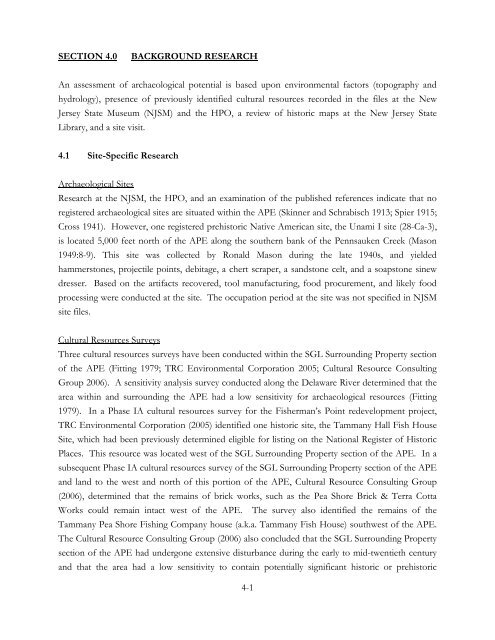APPENDIX D Cultural Resources Survey Report - US Environmental ...
APPENDIX D Cultural Resources Survey Report - US Environmental ...
APPENDIX D Cultural Resources Survey Report - US Environmental ...
You also want an ePaper? Increase the reach of your titles
YUMPU automatically turns print PDFs into web optimized ePapers that Google loves.
SECTION 4.0 BACKGROUND RESEARCH<br />
An assessment of archaeological potential is based upon environmental factors (topography and<br />
hydrology), presence of previously identified cultural resources recorded in the files at the New<br />
Jersey State Museum (NJSM) and the HPO, a review of historic maps at the New Jersey State<br />
Library, and a site visit.<br />
4.1 Site-Specific Research<br />
Archaeological Sites<br />
Research at the NJSM, the HPO, and an examination of the published references indicate that no<br />
registered archaeological sites are situated within the APE (Skinner and Schrabisch 1913; Spier 1915;<br />
Cross 1941). However, one registered prehistoric Native American site, the Unami I site (28-Ca-3),<br />
is located 5,000 feet north of the APE along the southern bank of the Pennsauken Creek (Mason<br />
1949:8-9). This site was collected by Ronald Mason during the late 1940s, and yielded<br />
hammerstones, projectile points, debitage, a chert scraper, a sandstone celt, and a soapstone sinew<br />
dresser. Based on the artifacts recovered, tool manufacturing, food procurement, and likely food<br />
processing were conducted at the site. The occupation period at the site was not specified in NJSM<br />
site files.<br />
<strong>Cultural</strong> <strong>Resources</strong> <strong>Survey</strong>s<br />
Three cultural resources surveys have been conducted within the SGL Surrounding Property section<br />
of the APE (Fitting 1979; TRC <strong>Environmental</strong> Corporation 2005; <strong>Cultural</strong> Resource Consulting<br />
Group 2006). A sensitivity analysis survey conducted along the Delaware River determined that the<br />
area within and surrounding the APE had a low sensitivity for archaeological resources (Fitting<br />
1979). In a Phase IA cultural resources survey for the Fisherman’s Point redevelopment project,<br />
TRC <strong>Environmental</strong> Corporation (2005) identified one historic site, the Tammany Hall Fish House<br />
Site, which had been previously determined eligible for listing on the National Register of Historic<br />
Places. This resource was located west of the SGL Surrounding Property section of the APE. In a<br />
subsequent Phase IA cultural resources survey of the SGL Surrounding Property section of the APE<br />
and land to the west and north of this portion of the APE, <strong>Cultural</strong> Resource Consulting Group<br />
(2006), determined that the remains of brick works, such as the Pea Shore Brick & Terra Cotta<br />
Works could remain intact west of the APE. The survey also identified the remains of the<br />
Tammany Pea Shore Fishing Company house (a.k.a. Tammany Fish House) southwest of the APE.<br />
The <strong>Cultural</strong> Resource Consulting Group (2006) also concluded that the SGL Surrounding Property<br />
section of the APE had undergone extensive disturbance during the early to mid-twentieth century<br />
and that the area had a low sensitivity to contain potentially significant historic or prehistoric<br />
4-1

















